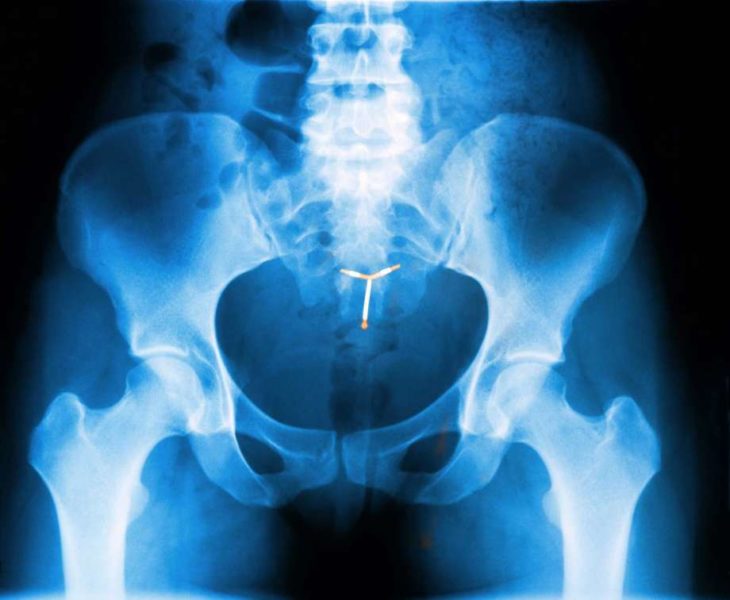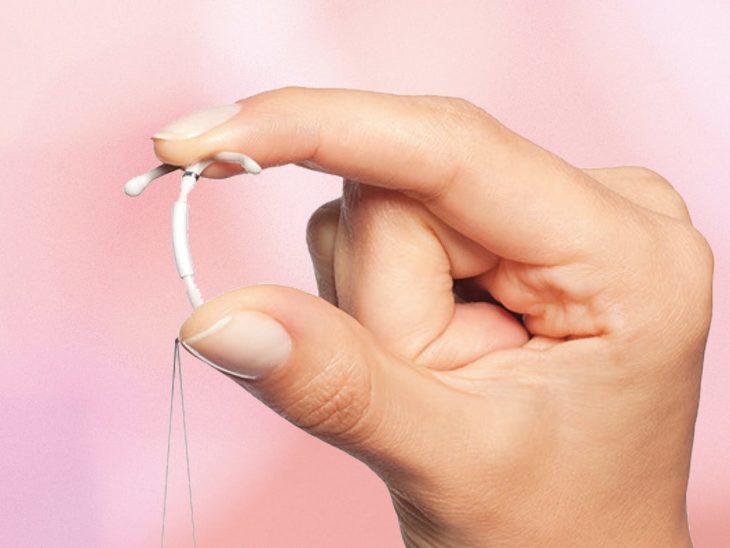The first time I went in to get my intrauterine device, or IUD, my doctor asked me if I was in a relationship.
“Um, kind of?” I stammered. “I mean, no. But you know, I hear this is the way to go as far as, you know, protectiveness.”
“Hrm,” she said, flipping her chart closed. This was the first time I’d been to this gynecologist, who ran her practice in my tiny suburban hometown. I was 20, home from school on Christmas break, and tired of frantically eyeing the moon and waiting for my period once a month.
“You realize that IUDs don’t protect against STDs, right?” she asked me, straightening the pamphlets on the counter. “You still should be using condoms.”
“Oh, I know,” I assured her. “And I do!” Usually.
“So why do you need an IUD?” she fired back.
“Just in case,” I said, trying my best to stare her down. She was blonde, and pretty and had been perfectly nice to me up until 10 minutes prior.
She looked back at me, then shrugged. “Fine. But since you haven’t given birth, it might not take.”
“Guess we’ll have to see!” I said brightly, shucking my pants.

Source: Man Repeller
She was right. It didn’t take. One night about two weeks later, I felt something hard and plasticine poking out of my cervix. After some frantic Googling the next morning, I snuck out of my first class — Reproductive Science, go figure — to call the local Planned Parenthood. I had to go in right away, they told me, lest the copper further dislodge itself and tear my cervix. I should also try to get hold of some Plan B, since, as luck would have it, I’d totally taken the kit-and-caboodle for a test drive the night before.
As it transpired, my original doctor hadn’t properly measured my uterus before popping the little guy up in there. I’d like to think she’d tried to insert it properly, and that my womb had somehow conspired to have fetus-company by blowing up like a fertile balloon. But a tiny, nasty part of me wonders whether she’d have done a better job if she’d concentrated less on berating me for my choices and more on the actual, y’know, measurement process.
And, as it happens, I was one of the lucky ones. I’ve had friends whose doctors have out-and-out refused to prescribe them IUDs, asking them to stick with the Pill because of their relationship statuses or hormonal needs. Small wonder that with attitudes like these so seemingly ubiquitous, the IUD is one of the least common contraceptive methods in the U.S, despite being the most common method worldwide. Had I not been buoyed at my doctor’s appointment by my own jerkassery and determination, it’s likely I would have just given up and fled at the reminder of my perennial singlehood.
I’ve always been a little,shall we say, paranoid about birth control. At some point in my youth, I’d imprinted on the idea that there are three methods of contraception –- barrier, chemical and hormonal –- and that for maximum effectiveness you should use at least two out of three. The first time I had P-in-V sex with a cis dude, I insisted on using a condom and spermicide and birth control pills, just in case his sperm grew legs like tadpoles and clung to the inside of my vagina for weeks.
(Yes, sex with me is a fun adventure-romp of spontaneity! How’d you guess?)
I was really great at taking the Pill at the same time every day, but the hippie-dippy vegan part of me felt a little weird about flooding my body with hormones all the time. More importantly, I just knew that if anyone hit in that 2 percent surprise! pregnant category, it’d be me. The IUD, on the other hand, was 10 times as effective, good for five years, and didn’t require me to set a cell phone alarm that flashed YOU WILL HAVE A BABY at me every night at 10 p.m.

Source: Gulf Coast Health Center
In fact, it’s such an effective contraceptive that the American College of Obstetricians and Gynecologists, or ACOG, has started to recommend it as a primary form of birth control for teenage girls. Mass prescriptions seem like a no-brainer, right?
Sadly, not so much. According to Mother Jones, the reason that many doctors give their patients the run-around is that they still suffer from incorrect, outdated information about IUDs. Because of unhygienic and occasionally lethal problems with shoddy IUDs in the 1970s, lots of doctors feel uncomfortable about prescribing them to their patients. Even today, the fear of big ol’ non-monogamous sluts like me getting an STD give many pause.
It is true that IUDs carry a slightly higher chance of contracting Pelvic Inflammatory Disease and that you risk becoming sterile if you get an STD while you have an IUD. This idea, however, that sticking a copper T in your womb will somehow make you forget what a condom looks like is preposterous.
Yes, my uterine reinforcements have occasionally made me feel a little more relaxed about my partners’ hypothetical super sperm. When I have chosen not to use condoms as a result, though, it’s not a decision I take lightly; it’s been with partners who have been thoroughly tested and who aren’t “fluid-bonded” with anyone else at the time. But that doesn’t mean I’m going to burn all my Trojans in a mocking effigy of wanton future STDs.
The Mother Jones article above, while incredibly comprehensive, fails to touch on what strikes me as a major detriment to the IUD’s popularity: the moral issue. Unlike the Pill, an IUD can’t be nicely wrapped in a non-sexual gift bag for any concerned parents or nosy friends. When ACOG wants to give prescriptions to all those under-18 teenagers, lots of the girls are going to somehow have to convince their mothers that the IUD helps with acne and cramping, too.
Even for young adults like me, the understanding that you’re going to use the IUD to go have lots of pre-marital sex seems to alarm some doctors on a less-than-purely-physical level. At the time I got my IUD, I was only sleeping with one person — if I’d called it a relationship, would my doctor have still given me a hard time?
Additionally, no one really seems to know just how an IUD works. A part of the copper IUD’s methodology, for example, is “reducing sperm motility” — but a big part is also blocking a fertilized egg from implanting. Some of those pesky “life begins at conception” bills effectively make IUDs illegal. And for those of you who believe that life does begin at conception, it may be harder to reconcile the metaphorical goalkeeper swatting at your fertilized egg.

Source: New Haven Register
Finally, in the U.S., it’s just kind of a mysterious prospect to many women. Unlike in other countries (where, apparently, you can get GOLD IUDs), there are only two brands available to American women. Because of near-constant marketing, I bet you can name at least three brand names for the Pill. I’ve never seen a single IUD ad, however. Before I started researching, I’d never even heard of it as a contraceptive option. Perhaps this is because of the aforementioned moral issue; more likely, it’s that sticking a plastic action figure in your uterus isn’t really the most marketable plan for Saturday night. The result, unfortunately, is that women don’t really know that IUDs are even available, let alone that they’re a viable topic for discussion. For once, I’m a little sad at the lack of commercials.
If you’re interested in getting an IUD, I’d say go for it. Not having to worry about literally anything pregnancy-related has been an incredible relief, especially for someone as epically paranoid as I am. I will say, however, that if you’re prone to heavy periods and severe cramping, the copper IUD is probably not for you. I’d never had bad cramps in my life before my IUD insertion, but every month like clockwork now finds me curled up in the fetal position and listening to Joni Mitchell. Some days I feel like my uterus is trying to turn itself inside out like one of the world’s tiniest, least-stylish reversible sweaters.
The copper also makes you bleed like crazy: My first few days of each period are spent dumping out my Diva Cup every hour on the hour and praying for sweet, clean-handed relief. It is, however, cheaper, and most insurances will cover at least part of the $500 or so it costs to get it implanted.
The hormone-releasing Mirena, on the other hand, makes periods vanish. They are more expensive and carry a higher reported rate of uterine perforation, so take heed accordingly. Though hopefully you all realize this, I am in no way qualified to give medical advice; I will say, though, that you should be comfortable asking for a second opinion when necessary, particularly if your original doctor is belittling or ignoring your wishes.
And, like all contraceptive methods save sterilization, there is some risk of failure with both kinds, though it’s usually to do with equipment displacement. I actually had a bit of a scare shortly after my first IUD took a slip-and-slide, but it was shortly rectified by my body’s apparent realization that I have a barren, tumbleweed-ridden wasteland where a mothering instinct might be. My second IUD has had no such problems.

Source: Business Insider
And you know what I don’t have to do? Renew my prescription every six months; randomly incur Pill Acne, which is a phenomenon that I alone seemed to have experienced but which was the worst side effect ever; deal with adjusting for time zones and prescription refills and insurance coverage every time I move to a new place, even only temporarily. Small inconveniences, mostly, until it’s the day before the box runs out and you find yourself with $5 in the bank. Then, it becomes a “crying at the CVS” situation, one with which I am intimately familiar.
Instead, with the IUD, I’ve just been able to “set it and forget it,” as ACOG puts it, and go along my merry, slutty way. Huzzah!
Original by
